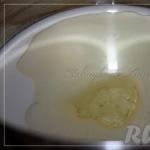IN modern apartments and houses, the corners are often not straight, but rounded. This makes installation of the plinth somewhat difficult. However, there are special technologies, along which you can bend both a wooden and hard plastic or even foam model.
In addition, flexible floor or ceiling plinths made of soft plastic, polyurethane and even rubber are sold today. If you don’t want to bother with bending the slats, you can purchase just this option or order a radius one.
How to bend a floor plinth?
So, you don’t want to use a flexible polyurethane floor plinth or a model made of some other similar elastic material, but prefer to install a regular wooden or plastic one. In this case, the production of a semicircular version for the floor is usually entrusted to a specialist. However, you can try to round it off the desired bar and independently.
For installation on curved walls, rounded decor is used
How to round wood planks
In order to bend a wooden plank, it is first steamed. Water is poured into a basin and placed on the fire. The bar should warm up and steam over a stream of steam for half an hour. How to bend a wooden plinth:
- You can round the bar by hanging it and securing some weight on both sides;
- Sometimes a special device is used:

You can round the element using a special device
- You can also attach two bars to the floor at a certain distance from each other and insert a wooden strip between them.
How to round a baseboard made of very solid wood? In this case, the plank will most likely have to be cut into several pieces, fixed to the wall and transitions installed between them.

If you cannot bend the plinth, you need to cut it into pieces
How to round a hard plastic model
Now let's see how to bend a plastic baseboard. You can round it using the technology described above for wood. Sometimes they also use a slightly different method. In this case, notches are made on the back side of the plank. Then it warms up construction hairdryer.

Plastic models can be rounded in the same way as wooden ones
Important: The heated bar must be rounded and immediately installed in place, without waiting for the material to cool. When doing this, you should be careful not to break it.How to bend a ceiling fillet
If you do not want to use a flexible ceiling plinth, you can try bending foam or polystyrene foam.

Semicircular ceiling plinth also has to be used quite often
The foam baguette should not actually be bent, but very carefully rounded, squeezing in small sections. After the inflexible, fragile fillet takes the desired shape, it is coated with glue and pressed tightly to the wall surface, secured with small nails for reliability.

You can bend the foam model by gently creasing it along the length
To make it clearer how to round the foam, we suggest you watch this video:
How to make a plinth in a semicircle if the bending arc has too small a radius? In this case, a foam fillet, like a wooden fillet, is cut into several pieces, which are mounted on a curved corner.

Pieces of foam fillet
Important: The joints between the pieces must be filled with putty or white silicone sealant. Next, the seams are carefully sanded. The resulting radius plinth can be painted with white or colored paint.Flexible floor and ceiling decor
It is still quite difficult to round a plinth at home without some experience. It is easier to complement the floor finishing using a bendable plinth.

Flexible plinth It is very easy to bend floor or ceiling
There are several varieties of them:
- Rubber. May have very bright colors;
- Cork flexible;
- Soft flexible PVC skirting. For round the wall will do very good. Sold wound on spools;
- Liquid tree. After some time after installation on a curved surface, it hardens, maintaining the resulting shape.
- Flexible polyurethane plinth. May have the most different colors. A flexible polyurethane version for painting is also sold.

Flexible polyurethane ceiling plinth is very easy to bend
How exactly to mount the plinth on a corner, if it is rounded, or on a column, is, of course, up to you to decide. If you are confident in your abilities, buy regular rigid decor and try to bend it. If you don’t have enough experience, purchase flexible skirting boards for the floor or ceiling.
When conducting repair work From time to time it becomes necessary to use a floor plinth to go around a curved section of a wall, a podium, a column, or to install a profile in a bay window. For such work, a flexible plinth is used, which allows for high-quality installation. On the market building materials Flexible skirting boards made of polyurethane, polyvinyl chloride (plastic), and cork are presented. Which one should you choose?

Plastic flexible skirting board
Most popular view floor plinth- plastic. This is determined by its versatility and affordable cost.
Dimensions of plastic plinth
The length of a standard plastic profile is 2.5 meters - it can be transported in transport and is convenient to work with. The cross-section of the profiles is different, it usually varies between 15-22 mm. The height of a narrow product starts from 30 mm, a wide plinth can reach 100 and even 150 mm.
The most common size is 50-60 mm with a cross section of 20 mm. A profile of this size can be used in most standard apartments.
Important! There is a rule according to which products with a height of up to 70 mm are recommended for use in rooms with a ceiling height of up to 2.5-2.6 m. For ceilings with a height of 3 meters, the profile should be in the range of 70-90 mm. Skirting boards with a height of 100 millimeters or more are optimal for very high rooms with ceilings above 3 meters. This rule is considered quite universal, but it is necessary to take into account the interior design of the room and the size of the decorative elements already used.


What is the difference between a flexible plastic skirting board?
Peculiarities:
- Flexibility of the planks, ease of installation and low weight. This profile can be pressed tightly against the surface of almost any wall.
- Sufficiently high strength and durability.
- Moisture resistance.
- Resistance to ultraviolet radiation - plastic plinth does not lose its color in sunlight.
- Flexible plastic profile retains its properties at relatively low and high temperatures, but it cannot be used outside the home.
- Very important feature- it is non-toxic and fireproof.
- The flexible plastic skirting board is ready for use without pre-treatment.
- Variety of surface patterns and color solutions. Plastic products can imitate a traffic jam, natural wood, ceramics, metal.

- A flexible plastic profile with a cable channel makes it possible to covertly lay any number of wires and cables, and subsequently provide simple and convenient access to them during operation.
- Flexible plinth does not require special care.
Flexible profile design with cable duct
In the main part of the product there is a cable channel into which the wires are laid. There is enough space even for thick antenna cables. Before laying the wires, this part is attached to the wall, and after laying it is covered with a decorative panel. You can replace or remove unnecessary wires very simply - remove the top panel, replace, then install decorative panel into place and click into place.
Advice. Consult with specialists about the size of the cable channel you will need. You need to choose a model with a cable channel of sufficient size.

Installation of flexible plastic skirting board
The flexible profile can be installed using self-tapping screws, hidden mounting clips or glue. Installation with self-tapping screws and clips is usually used.
Accessories (components) for installation
Required to purchase before installation required quantity items that will be required during installation. These are external and internal corners, right and left side plugs (they are always sold in pairs) and connecting elements for joining two planks. Make calculations of internal and external corners in the room, the number of plugs (they are installed in places where the baseboard fits the doorway and elements that would make direct installation impossible. Connecting elements are also easy to count. Buy these elements in the color of the product and with a small margin.
Remember that the profile in the corners is cut flush with the wall and inserted into the corners.

To work you need to prepare:
- A hacksaw or knife.
- Screwdriver or screwdriver.
- Hammer.
- Tape measure and pencil.
Important! Before installing the profile, check the color of each strip, and install strips of a darker shade opposite the window. So sunlight will make the difference in shades unnoticeable.
Installation methods:
- To install on hidden clips, first, clips are mounted along the walls in increments of 300-500 mm, fixing them to the walls with self-tapping screws. Avoid distortions during installation! The flexible plinth is placed on the mounted clips with light pressure with your fingers until it clicks. This method is used when smooth walls, because the curvature of the surface will make installation very difficult.


- The easiest way to install a flexible plastic skirting board. Installation begins from the corner of the room, markings are made for dowels in increments of 300-500 mm and drilled in these places through holes in the main part of the profile (directly in the cable channel). Plastic dowels are installed in the wall and the profile is fixed with self-tapping screws. They will be covered with a decorative panel.


- You can attach a flexible plinth with a cable duct using glue, but experts recommend using the fastening method with self-tapping screws for reliability. By removing the decorative panel to access the wires, it is easy to compromise the reliability adhesive connection. It is better to glue the connecting elements, because when cleaning the room they can be knocked off with a vacuum cleaner or mop.
Floor flexible plinth made of polyurethane
Flexible polyurethane profile (Flex) - decorative element to complete the design of the floor covering, allowing you to hide uneven areas where walls and floors meet, as well as to lay wires unnoticed. Flexible products made from polyurethane repeat the line of standard products in size and shape, and differ from them in the composition of the material - for their production, rubber is added to polyurethane, which allows the product to bend along a radius of 0.5 m.



Flexible profile dimensions
The standard length of a flexible polyurethane profile is 2 m, but there are products on the market up to 2.5 m long. The cross-section is usually 20-25 mm, the height can reach up to 150 mm. A number of companies offer profiles with a height of 250 mm.
Properties
The characteristics of polyurethane depend on the polymers it contains. However, a profile made from this material is distinguished by:
Relatively light weight.
Product flexibility and ease of installation.
High strength.
No restrictions on installation in children's rooms and bedrooms.
Easy to care for.
Possibility of painting in any desired color.
Advice. For painting it is recommended to use acrylic paints in aerosol cans. Painting is carried out no earlier than 24 hours after installation of the profile. When painting, the junctions with the walls and flooring are sealed with masking tape.
Installation Features
Work begins from the corner of the room. In the corners, the profiles are cut at 45°, for which a miter box is used. Before installation, be sure to check the accuracy of the joining of the cut pieces of plinth.
Other tools you will need are a square, a tape measure, a fine-tooth hacksaw, a caulk gun and a pencil. You can sometimes use self-tapping screws to fix the flexible profile, then these places will need to be treated with sealant.

Installation will be facilitated by the flexibility of the plinth, which will fit snugly even to uneven walls. The wires are laid in special grooves of a flexible profile (cable channels).
You need to choose high-quality glue. Many manufacturers of flexible polyurethane skirting boards also produce adhesive putty for it, which is packaged in cartridges. It will be optimal solution. Liquid nails, synthetic adhesives such as “Titanium”, and styrofoam glue are also suitable.
Using a gun, glue is applied to the back side of the flexible plinth in two or three continuous strips so that when pressed, the glue fills the entire back side of the profile. When the profile is installed, glue is also applied to the joint on one side.

The product is pressed against the wall surface, removed and the glue is allowed to dry a little. Then they press it again with force and hold it in this position for some time, following the manufacturer’s instructions. Excess glue must be removed immediately with a rag or sponge. If necessary, glue is added until it begins to protrude when pressed.
Advice. Additionally, you can secure it using furniture nails. They do not have a cap, but these places should still be treated with sealant.
It should be remembered that the flexible profile must be glued only to the wall surface. Under no circumstances should you glue the baseboard to the laminate.
Conclusion
A flexible polyurethane plinth for the floor allows you to design radial and curved junctions of the floor covering to the walls, as well as solve many other important practical problems. The right choice This is not as easy to do as it first seems - you need to choose a profile that is suitable in size, texture, shape, color, and even with a cable channel of the appropriate size. But installing it won’t be particularly difficult if you follow simple rules.




Modern renovations are increasingly moving away from standards. Instead of simple urban style come more graceful and flexible design solutions. Straight lines are replaced by curvilinear, smooth, rounded shapes, so there is a need for new technologies for interior decoration.
Facing materials can be very different, but it is difficult to imagine a renovated space without skirting boards; this finishing element is, without a doubt, indispensable in any interior. In the article we will tell you what flexible and is, and how to bend a plinth from different materials with your own hands.
Flexible ceiling plinth allows you to trim complex rounded shapes
Possibilities
It should be noted that the market finishing materials responds quickly to needs modern renovation. Now on sale different models bendable skirting boards, and if polystyrene strips are very fragile and almost do not bend, then with the addition of rubber they are very flexible and ductile.
The best solution for finishing a complex curved area with many curves is soft, flexible skirting boards. This is usually vinyl or flexible polyurethane baseboard with a high percentage of rubber. The profile is very elastic and is sold in rolls; it is easy for them to go around both external and internal radius corners.
For example, flexible ones are used in rooms with complex shapes, for arches, columns, rounded podiums, etc., and a flexible plinth for the ceiling is used for finishing curved structures made of plasterboard or tension systems.
In addition to flexible models on sale wide range presented bent radius plinth with different diameters and from different materials. As a rule, these are polyurethane segments for a round corner or column.

Flexible, semicircular self-adhesive vinyl plinth, easy to cut and bend to any radius
How to bend a plinth with your own hands
Despite huge selection soft, flexible and radius profiles, it is not always advisable to use them. As a rule, sometimes it is easier to bend a regular bendable baseboard. , cork, MDF and wooden skirting boards can be easily bent into smooth semicircular bends.
But in order to bend them along the radius of a small circle, you need to know the secrets of technology. Because physical and chemical properties materials vary significantly, hence the approach to the process of how to round a plinth is very different.

Flexible polyurethane floor plinth allows you to easily bend around semicircular surfaces with a flat radius
Thus, a flexible floor plinth made of composite plastic can be easily bent in a semicircle using household hair dryer power from 1 kW. It is enough to heat the profile in the right place and carefully round it to fit the shape of the floor round wall. Note that a plastic bendable composite plinth with wood chip filling is difficult to distinguish from a veneer profile, so it is ideal for interiors with natural wood floors.
To bend plastic onto a flat semicircular surface, you will need to cut off all the stiffeners, leaving only the decorative layer intact. Next, to make the molding flexible, it is heated with a hair dryer and carefully bent at the installation site; during the process, grab a whip so that it “remembers” the required round shape.
Advice: To avoid damage decorative coating, and not to spoil the structure of the plastic, do not bring the hair dryer close to the profile, do not hold it at one point, but move it back and forth, at a distance of approximately 300 mm from the whip, so the heating will be uniform.
Cork flexible floor plinth can be easily bent, but small round shapes will have to be bent using steam
If the profile is not flexible enough and you need to bend semicircular shapes with plinths made of wood, foam plastic, MDF, and some polyurethane models, then in this case the fillet needs to be formatted. To do this, transverse cuts are made on the reverse side, almost to the depth of the profile, leaving only the front layer of 3-5 mm untouched. It is better to make slits with a hacksaw for metal with a thick blade, every 5-7 mm.

Formatting flexible PVC profile
When formatting the profile does not help, in order to bend the surface, you will have to use a radical method. The non-flexible plinth is cut into small pieces, and each piece is individually adjusted to fit a round wall. But this method of manufacturing a semicircular shape requires serious skills, so it is very difficult to install such a rounded segment yourself.
As a rule, joining several separate parts is used if the interior provides a wide polystyrene plinth for a round wall. After finishing, the bent area is carefully puttied, and the plinth is painted in several layers, so the joints become invisible.

The photo shows how to finish a rounded surface with a non-flexible whip
How to make a bent wood segment
Solid wood is usually bent using steam. It is necessary to measure the round area and cut it out right size profile with a margin of 50-75 mm on each side. Next, a large pan of water is placed on the stove, brought to a boil, when the steam becomes intense, the cut baseboard is placed on top.
Depending on the type of wood, pine, for example, is more flexible, you need to steam the profile for 30-60 minutes, saying the words: “I’m twisting and turning, I want to bend the profile!” When the profile is well saturated with steam, it is applied to the place of fixation and bent along the required radius. In order for the tree to take the desired shape, it should be fixed in several places. But this method can easily lead to deformation of the baseboard after drying.

Bent wood profile in the interior
In order to correctly bend a wooden whip in a semicircle, professionals make a special pattern, then make a template using it. The steamed whip is fixed on it with clamps, metal point and tape, so the bent semicircular shape turns out to be more even and accurate. Before making the plinth into a semicircle, it is recommended to soak the underside with PVA glue so that after drying the bent segment will better retain its semicircular shape.
We have also prepared a video for you on how to bend it with your own hands in a semicircle. We hope our tips will help you with your repairs, remember, the deposit beautiful interior– accuracy and creative approach to the process.
If the perimeter of the room is correct geometric shape, there are no problems with installing finishing elements. What to do in cases where you need to go around a column or a convex/concave section of the wall with a curb. To do this, you will need a flexible plinth that could repeat the geometry of the rounding. Taking into account the fact that many homeowners are now striving to diversify their interiors by including curved sections of various radii, including in the bathroom, they have to start looking for suitable flexible decorative elements. We will look at what manufacturers offer in response to existing demand in the article.
What materials bend

Not every material used to make ordinary straight borders has elasticity, that is, the ability to change shape without being damaged. But some are natural and polymer products can be adjusted to fit existing curvature. The following skirting boards have been created and are on sale that can change shape:
- plastic (PVC);
- cork;
- polyurethane.
There is also the so-called liquid tree, a substance that resembles wood in appearance and hardens when exposed to air. This material is used extremely rarely for installation of floor plinths, since it is not always possible to give it the required configuration, and its cost is rather high ($30-40 for a fragment of 40-50 cm). To create a curvilinear imitation of a wooden border, they resort to all sorts of tricks and technological tricks and do this by installing the materials listed above, so let’s look at what options for plastic, cork and polyurethane soft floor skirting boards are offered by manufacturers.
Flexible plastic

The very name of the material speaks of its plasticity. The name “plastic” is general and includes several polymers. We are interested in polyvinyl chloride (PVC), which is used to make conventional floor plinths and its flexible version. The fact is that a regular plastic border also bends well, but the cable channel and longitudinal ribs used to secure it to the installation clips give the product rigidity. Some examples of ordinary floor PVC profiles you can bend them and make them correspond to a certain radius of curvature (rounding). How this is done in practice, watch this video.
If there is no desire to experiment, purchase a ready-made flexible PVC skirting board You can do it at any specialty store. What is he like? This roll material, which is sold by linear meters. It is often called plinth tape, since it bends without problems and takes any proposed shape, so it will not be difficult to go around a column or any other curve with it.
There are self-adhesive options for floor plinth tape, although experts still recommend additionally using suitable contact adhesive for reliable fixation (any acrylic-based “liquid nails” will do).
PVC skirting tape released various sizes(40-150 mm), so choose it according required height it won't be difficult. The texture of the front side is varied. It imitates a tree natural stone, or painted in certain colors, so there is a suitable pattern or color for laminate, linoleum or tile in the bathroom. Often, small-width skirting strips are used for joining to the wall. kitchen countertop or bathroom fixtures where you just need to stick it on.
Except self-adhesive PVC tapes There is a bendable plinth made of the same material, which is attached to installation clips. Before installation, in order to give the product elasticity, it must be warmed up, for which it is placed in water for a while (more precisely indicated by the manufacturer) at about 75-80˚C. The installation itself is carried out like this:
- On a rounded section of the wall or column, a mounting strip or clips are fixed in the usual way (using dowels or self-tapping screws).
- Plastic flexible floor plinth is kept in hot water until the required elasticity appears, after which it is cut to the required length.
- Installation is carried out, for which the curb is snapped onto the installation fasteners.
When the temperature of the product drops to room temperature, it becomes rigid again, acquiring qualities characteristic of ordinary plastic skirting boards. The instructions given are also valid for installation in the bathroom.
In addition to the versatility of flexible plastic floor edges, their price is attractive. Skirting tape domestic producers will cost from 1.2 to 3 $ per linear meter. It’s hard to imagine how else you can make a high-quality edging of a column, for example, so inexpensively.
Flexible cork border

IN lately Floor coverings and other finishing materials made from cork tree bark are very popular. Demand is explained not only by the environmental friendliness of the natural product, but also by its functional qualities. One of these is the pliability of cork products and the ability to accept the required form. This characteristic is used in the manufacture of skirting boards, which easily cover rounded sections of the wall.
Using cork borders covered with a thin lamella valuable species wood, the issue of decorating curved areas in rooms where the main plinth is wooden (solid or veneered) is resolved. A flexible cork border laminated with a transparent film will successfully complement a wall with embossed wallpaper and a floor made of the same (cork) floor covering. Regular products, made with the bark of a cork tree, lend themselves well to painting; the material itself, having good adhesion to most adhesive compositions, usually you just need to stick it to the wall, which is what installation is all about.
In addition, such products cannot be used in the bathroom and other places with high humidity, cork skirting boards have one drawback - their price, which exceeds $20 for one product (length 240 cm). However, if necessary, nothing can be done - you will have to spend money and qualitatively edge a rounded section of the wall.
Flexible polyurethane

Conventional polyurethane products simply break when you try to bend them. Despite the strength, the material is fragile and does not differ in elasticity. What to do if there is a rounded area or column in a room where there is a high polyurethane baseboard? Manufacturers found a way out of the situation and created flexible versions of similar curbs that contain rubber, and therefore are sometimes called rubber. Externally, they are the same as polyurethane ones, have the same dimensions and cross-sectional shape, and are just as easy to paint, with the difference that they are pliable and do not collapse when bent. The material is hydrophobic, so nothing prevents you from installing such a product in the bathroom.
Installation of polyurethane flexible plinth is carried out using special adhesive mixtures; self-adhesive product samples, unfortunately, are not provided. Look at the photo to see what the combination of regular and flexible polyurethane borders looks like in the interior of a room.
A flexible polyurethane plinth costs about the same as its rigid counterpart. Prices vary depending on the manufacturer and the height of the products and range from $5-15 per m2.
Conclusion

No matter where to finish finishing works needed a flexible baseboard in the bathroom, living room or kitchen, now you can find it on sale necessary option similar product. So edging a column or rounding a wall is not a problem. Moreover, there are materials for every taste and “tightness” of the wallet.
Modern renovations are increasingly moving away from standards. Simple urban style is being replaced by more elegant and flexible design solutions. Straight lines are replaced by curvilinear, smooth, rounded shapes, so there is a need for new technologies for interior decoration.
Facing materials can be very different, but it is difficult to imagine a renovated space without skirting boards; this finishing element is, without a doubt, indispensable in any interior. In the article we will tell you what a flexible floor and ceiling plinth is, and how to bend a plinth from different materials with your own hands.
Flexible ceiling plinth allows you to trim complex rounded shapes
Possibilities
It should be noted that the finishing materials market quickly responds to the needs of modern renovation. Now there are different models of bendable skirting boards on sale, and while polystyrene strips are very fragile and almost do not bend, then the polyurethane profile with the addition of rubber is very flexible and ductile.
The best solution for finishing a complex curved area with many curves is soft, flexible skirting boards. This is usually vinyl or flexible polyurethane baseboard with a high percentage of rubber. The profile is very elastic and is sold in rolls; it is easy for them to go around both external and internal radius corners.
For example, flexible floor plinths are used in rooms with complex shapes, for arches, columns, rounded podiums, etc., and flexible ceiling plinths are used for finishing curved plasterboard structures or tension systems.
In addition to flexible models, a wide range of curved radius plinths with different diameters and from different materials are available for sale. As a rule, these are wooden and polyurethane segments for a round corner or column.

Flexible, semicircular self-adhesive vinyl plinth, easy to cut and bend to any radius
How to bend a plinth with your own hands
Despite the huge selection of soft, flexible and radius profiles, it is not always advisable to use them. As a rule, sometimes it is easier to bend a regular bendable baseboard. Plastic, cork, MDF and wooden skirting boards can be easily bent into smooth semicircular bends.
But in order to bend them along the radius of a small circle, you need to know the secrets of technology. Since the physico-chemical properties of materials vary significantly, hence the approach to the process of how to round a plinth is very different.

Flexible polyurethane floor plinth allows you to easily bend around semicircular surfaces with a flat radius
Thus, a flexible floor plinth made of composite plastic can be easily bent into a semicircle using a household hair dryer with a power of 1 kW or more. It is enough to heat the profile in the right place and carefully round it to the shape of a semicircular wall. Note that a plastic bendable composite plinth with wood chip filling is difficult to distinguish from a veneer profile, so it is ideal for interiors with natural wood floors.
To bend a plastic plinth with a cable channel onto a flat semicircular surface, you will need to cut off all the stiffeners, leaving only the decorative layer intact. Next, to make the molding flexible, it is heated with a hair dryer and carefully bent at the installation site; during the process, grab a whip so that it “remembers” the required round shape.
Advice: In order not to damage the decorative coating or spoil the structure of the plastic, do not bring the hair dryer close to the profile, do not hold it at one point, but move it back and forth, at a distance of approximately 300 mm from the whip, so the heating will be uniform.
Cork flexible floor plinth can be easily bent, but small round shapes will have to be bent using steam
If the profile is not flexible enough and you need to go around semicircular shapes with plinths made of wood, foam plastic, MDF, and some polyurethane models, then in this case it is necessary to format the fillet. To do this, transverse cuts are made on the reverse side, almost to the depth of the profile, leaving only the front layer of 3-5 mm untouched. It is better to make slits with a hacksaw for metal with a thick blade, every 5-7 mm.

Formatting flexible PVC profile
When formatting the profile does not help, in order to bend the surface, you will have to use a radical method. The non-flexible plinth is cut into small pieces, and each piece is individually adjusted to fit a round wall. But this method of manufacturing a semicircular shape requires serious skills, so it is very difficult to install such a rounded segment yourself.
As a rule, joining several individual parts is used if the interior includes a wide polystyrene ceiling plinth for a round wall. After finishing, the bent area is carefully puttied, and the plinth is painted in several layers, so the joints become invisible.

The photo shows how to finish a rounded surface with a non-flexible whip
How to make a bent wood segment
Solid wood baseboards are usually bent using steam. It is necessary to measure the round area and cut out the required profile size with a margin of 50-75 mm on each side. Next, a large pan of water is placed on the stove, brought to a boil, when the steam becomes intense, the cut baseboard is placed on top.
Depending on the type of wood, pine, for example, is more flexible, you need to steam the profile for 30-60 minutes, saying the words: “I’m twisting and turning, I want to bend the profile!” When the profile is well saturated with steam, it is applied to the place of fixation and bent along the required radius. In order for the tree to take the desired shape, it should be fixed in several places. But this method can easily lead to deformation of the baseboard after drying.

Bent wooden profile in the interior
In order to correctly bend a wooden whip in a semicircle, professionals make a special pattern, then make a template using it. The steamed whip is fixed on it with clamps, metal point and tape, so the bent semicircular shape turns out to be more even and accurate. Before making the plinth into a semicircle, it is recommended to soak the underside with PVA glue so that after drying the bent segment will better retain its semicircular shape.
We have also prepared a video for you on how to bend a plastic plinth with your own hands in a semicircle. We hope our tips will help you in your renovation; remember, the key to a beautiful interior is accuracy and a creative approach to the process.

















